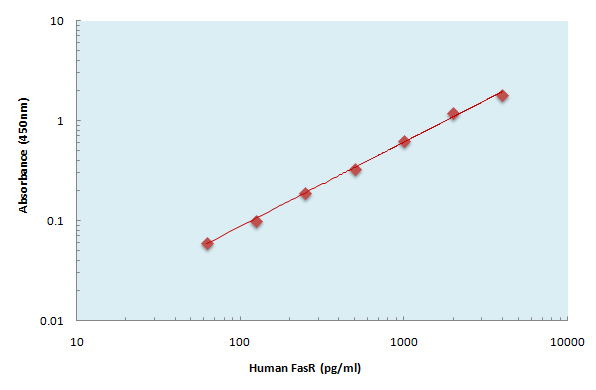- Home
- About
- Promotions
-
Products
-
Elisa Kits
- |
-
Primary antibodies
- |
-
Secondary antibodies
- |
-
Proteins
- |
-
IHC reagents
- |
-
WB reagents
- PonceauS Staining Solution
- PBST Washing Buffer, 10X
- 1.5M Tris-HCl Buffer, pH8.8
- 1M Tris-HCl Buffer, pH6.8
- 10% SDS Solution
- Prestained Protein Marker
- TBST Washing Buffer, 10X
- SDS PAGE Loading Buffer, 5X
- Stripping Buffered Solution
- Tris Buffer, pH7.4, 10X
- Total Protein Extraction Kit
- Running Buffer, 10X
- Transfer Buffer, 10X
- 30% Acr-Bis(29:1) Solution
- Tris电泳液速溶颗粒
- PBS(1X, premixed powder)
- TBS(1X, premixed powder)
- 快速封闭液
- 转膜液速溶颗粒
- Chemical reagents
- News
- Distributor
- Resources
- Contact
- Home
- >
- Info
- >
- Human FasR ELISA Kit
- >
- Go Back
Human FasR ELISA Kit
- Catalog No.:KE1120
- Applications:ELISA
- Reactivity:Human
- Protein Name:
- Tumor necrosis factor receptor superfamily member 6
- Specificity:
- Sample Type for Cell Culture Supernates, Cell lysates, Tissue Lysates, Serum, EDTA Plasma, Heparin Plasma
- Storage Stability:
- 2-8°C/6 months
- Other Name:
- FAS;APT1;FAS1;TNFRSF6;Tumor necrosis factor receptor superfamily member 6;Apo-1 antigen;Apoptosis-mediating surface antigen FAS;FASLG receptor;CD antigen CD95
- Detection Method:
- Colorimetric
- Background:
- disease:Defects in FAS are the cause of autoimmune lymphoproliferative syndrome type 1A (ALPS1A) [MIM:601859]; also known as Canale-Smith syndrome (CSS). ALPS is a childhood syndrome involving hemolytic anemia and thrombocytopenia with massive lymphadenopathy and splenomegaly.,domain:Contains a death domain involved in the binding of FADD, and maybe to other cytosolic adapter proteins.,function:Receptor for TNFSF6/FASLG. The adapter molecule FADD recruits caspase-8 to the activated receptor. The resulting death-inducing signaling complex (DISC) performs caspase-8 proteolytic activation which initiates the subsequent cascade of caspases (aspartate-specific cysteine proteases) mediating apoptosis. FAS-mediated apoptosis may have a role in the induction of peripheral tolerance, in the antigen-stimulated suicide of mature T-cells, or both. The secreted isoforms 2 to 6 block apoptosis (in vitro).,online information:Mutations in TNFRSF6 causing ALPS type Ia,similarity:Contains 1 death domain.,similarity:Contains 3 TNFR-Cys repeats.,subunit:Binds DAXX. Interacts with HIPK3. Part of a complex containing HIPK3 and FADD (By similarity). Binds RIPK1 and FAIM2. Interacts with BRE and FEM1B.,tissue specificity:Isoform 1 and isoform 6 are expressed at equal levels in resting peripheral blood mononuclear cells. After activation there is an increase in isoform 1 and decrease in the levels of isoform 6.,
- Function:
- cell activation, leukocyte homeostasis, adaptive immune response, immune effector process, lymphocyte homeostasis,immunoglobulin production, production of molecular mediator of immune response, leukocyte mediated immunity,lymphocyte mediated immunity, adaptive immune response based on somatic recombination of immune receptors built from immunoglobulin superfamily domains, immune system development, leukocyte differentiation, negative regulation of immune system process, regulation of leukocyte activation, negative regulation of leukocyte activation, renal system process, protein complex assembly, apoptosis, anti-apoptosis, induction of apoptosis, activation-induced cell death of T cells, inflammatory cell apoptosis, transformed cell apoptosis, immune response, cell death, induction of apoptosis by extracellular signals, activation of pro-apoptotic gene products, response to toxin, respon
- Subcellular Location:
- [Isoform 1]: Cell membrane ; Single-pass type I membrane protein . Membrane raft .; [Isoform 2]: Secreted.; [Isoform 3]: Secreted.; [Isoform 4]: Secreted.; [Isoform 5]: Secreted.; [Isoform 6]: Secreted.
- Expression:
- Isoform 1 and isoform 6 are expressed at equal levels in resting peripheral blood mononuclear cells. After activation there is an increase in isoform 1 and decrease in the levels of isoform 6.

- The Human FasR ELISA Kit allows for the detection and quantification of endogenous levels of natural and/or recombinant Human FasR proteins within the range of 63-4000 pg/ml.




